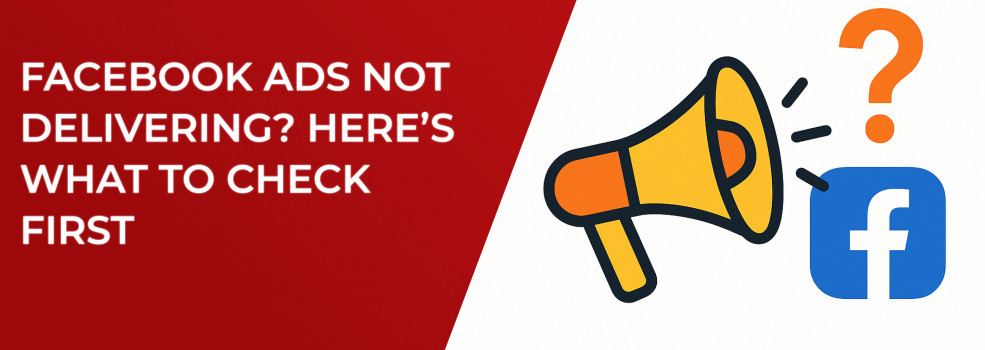Few moments in digital marketing feel worse than launching a shiny new campaign and seeing the impression counter sit at zero. Before you scrap your work or double the budget, walk through the checklist below. Each step addresses one of the five most common delivery blockers that appear in real-world accounts.
1 Check Whether the Learning Phase Is Stuck
Meta’s algorithm needs roughly 50 conversion events within seven days to stabilise an ad set. If you make edits too often, that counter resets and delivery stalls. To shorten that wait, you can follow the step-by-step tips in How to Finish the Facebook Learning Phase Quickly.
The “Learning Limited” status appears when your ad set doesn’t generate enough conversions to optimize delivery.
What to do right now
-
Open Ads Manager and look at the Delivery column.
-
If you see Learning or Learning Limited, merge similar ad sets so data pools faster.
-
Switch to Advantage Campaign Budget so Meta can shift spend where it is most effective.
-
Wait at least 48 hours without edits to let the algorithm collect stable data.
Give the system a full day after these changes before deciding whether impressions have improved. This patience alone often revives an ad set.
2 Confirm Audience Size, Overlap and Placement
Once learning status looks healthy, turn to targeting. An audience that is too small or overlaps heavily with another ad set will choke delivery even when everything else is correct. For a refresher on building healthy segments, check out Facebook Ad Targeting 101: How to Reach the Right Audience.
Run these checks inside Ads Manager
-
Aim for one to two million users on top-of-funnel campaigns.
-
Use Show audience overlap; anything above 30 percent means you are bidding against yourself. This post on The Role of Audience Overlap in Facebook Ads Performance shows how to measure and fix the issue.
-
Start with Advantage+ placements and trim only after data shows a placement hurting click-through rate.
After updating audiences, monitor reach and CPM for 24 hours. A falling CPM paired with growing impressions is a strong sign you fixed the bottleneck.
3 Align Budget and Bid Strategy
Budgets and bid caps tell Meta how aggressively to enter auctions. If either number is out of sync with your goals, delivery can freeze even with perfect targeting.
A quick reference for common misfires:
If you’re weighing daily versus lifetime spend limits, Daily vs Lifetime Budgets: What's Better for Facebook Campaign Performance? lays out the trade-offs.
Change only one variable at a time and allow a full day for recalculation. A sharp drop in CPM accompanied by more impressions shows that your adjustment worked.
4 Audit Creative and Engagement Signals
With budgets aligned, creative quality becomes the next make-or-break factor. Meta rewards ads that capture attention quickly.
-
Maintain CTR (all) above 0.8 percent across placements.
-
Target a News Feed CTR between 1 percent and 1.5 percent.
-
Refresh hooks, test 9:16 video formats and match ad copy tightly to the landing-page promise.
Even a small lift in CTR can lower CPM by several dollars, helping the entire campaign regain momentum.
5 Verify Tracking, Pixel and Conversions API
Meta cannot optimise what it cannot measure. A mis-firing pixel or missing event will shut off delivery faster than any creative issue.
-
In Events Manager, confirm your goal event (Purchase, Lead, etc.) lights up green in real time.
-
Make sure each campaign’s objective matches the event actually firing. For help choosing the correct optimisation event, see Meta Ad Campaign Objectives Explained: How to Choose the Right One.
-
Implement the Conversions API alongside the pixel to protect data flow on iOS devices.
After fixes, watch for conversions to register within a few hours. A move from Learning to Active status often follows quickly.
6 Use Benchmarks to Spot Outliers
Reliable yardsticks help you see whether a metric is genuinely broken or simply fluctuating.
Compare seven-day averages to these ranges before making sweeping changes. Isolate one outlier, fix it and re-evaluate overall ROAS before chasing further gains. To understand whether your clicks are truly on target, compare your numbers with the insights in What’s a Good CTR for Facebook Ads? Benchmarks and Tips. Isolate one outlier, fix it and re-evaluate overall ROAS before chasing further gains.
One-Minute Troubleshooting Flow
When impressions vanish or costs spike, run this short list in order:
-
Delivery status – Learning or error flags?
-
Audience health – size and overlap within targets?
-
Budget and bids – aligned with CPA goals?
-
Creative engagement – CTR meeting benchmarks?
-
Tracking integrity – pixel and Conversions API firing correctly?
Solving just one weak link often restores delivery without a complete rebuild.
Final Takeaway
A silent ad set is rarely broken everywhere. More often, a single weak point — learning status, audience setup, budget alignment, creative fatigue or tracking failure — blocks Facebook from entering auctions confidently. Move through these checkpoints methodically and give each change time to settle. You’ll fix most delivery problems without gutting your campaign or ballooning costs.

